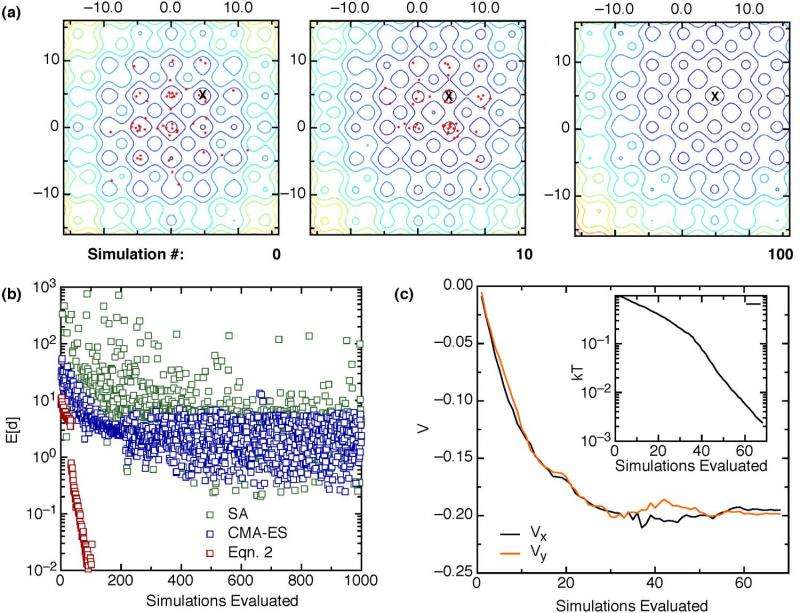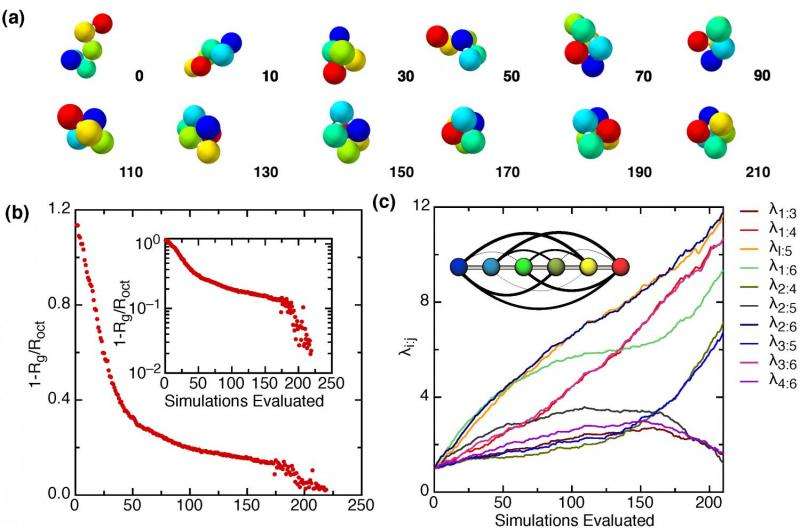February 10, 2016 feature
Materials by design: A radical shift in transforming bulk matter into useful technology

(Phys.org)—Statistical physics – the branch of physics that solves physical problem by using methods of probability theory and statistics (specifically, mathematical tools for large populations, approximations, and other fields with an inherently stochastic nature) – excels at predicting the properties of materials for given parameters. However, the inverse ability to identify required components and their structural configuration for given target properties is still in its nascent stage – and current optimization- and simulation-based techniques that either do not utilize the material's configuration space (the vector space defined by the parameters that characterize a physical system's configuration) or require carefully-tuned algorithms applicable limited to a narrow subclass of materials. Recently, however, scientists at The University of Chicago created an algorithm that systematically identifies which materials produce a target response, thereby providing the capability to automatically create increasingly complex materials with desired properties from design specifications alone. Moreover, the researchers showed that their algorithm is faster and more reliable than standard optimization methods techniques without increasing implementation complexity. As a result, the scientists state that their approach provides novel solutions for a wide range of complex optimization and design problems.
Dr. Marc Miskin discussed the paper that he and his co-authors published in Proceedings of the National Academy of Sciences. "The key challenge that we faced in producing our approach to materials design was balancing the two conflicting goals of efficiency and range of use," Miskin tells Phys.org. "For instance," he illustrates, "one road to materials design is to build a highly specialized optimizer designed to work well on one specific class of materials. In this case, the result is usually a very fast, very efficient method, but it achieves this at the cost of only being useful for a very narrow class of problems." On the other hand, he points out, the inverse is also problematic. "If you make no assumptions about the material you are trying to design, the resulting method can be used broadly over a range of material types, but this comes at the cost of being outperformed by specialized methods."
Miskin and his colleagues sought to transcend these limitations. "Our big challenge was to find the best middle ground: We wanted to make our method broad enough to work over a large scope of materials classes, but to have enough specialization to outperform methods that aren't tailored to materials design." Their paper describes their initial progress towards achieving that goal. "We present a formalism that can be used to transform the capacity to predict material behavior into an optimizer that tunes it. Furthermore," he adds, "we found that our formalism often solves optimization problems faster and more reliably than approaches built around black-box optimization methods."

Miskin notes that since materials design is a new concept and therefore no standard tests to evaluate new optimizers exist, demonstrating how these optimizers are easy to implement yet faster and more effective required that the researchers invent a set of optimization test problems. In so doing, they found that a robust materials optimization scheme had to address five key challenges:
1. Solve problems where the search landscape has little variation between candidate materials
2. Solve problems juggling multiple potentially competing physical effects
3. Operate in high dimensional search spaces
4. Tune the processing conditions to which a material is subjected
5. Operate on real-world scale optimization problems
The researchers then translated these challenges into physical test problems and compared their novel approach to optimization schemes they previously used successfully for materials design, Miskin explains. "Given the the criterion that the best optimizer is the one that has to make the fewest guesses to arrive at the material that performs a target function," he adds, "the new optimizer outperformed our old standards."
Developing their novel algorithm required innovative thinking. "Statistical physics tells us that materials are intrinsically statistical objects – that is, a bulk material and its properties are best calculated by averaging over all possible configurations of the material's microscopic components," Miskin says. "Our insight was that design programs should focus on tailoring materials at the microstate, rather than the bulk emergent property, level." (In statistical mechanics, a microstate is a specific microscopic configuration of a thermodynamic system that the system may occupy with a certain probability in the course of its thermal fluctuations.) He gives the example that if one knows that pressure and temperature affect a material's stiffness, and one wants to set these two parameters to make the stiffest material, the traditional approach is to view this as an optimization problem with pressure and temperature as inputs and stiffness as an output.

"However," Miskin stresses, "this view completely ignores the microstates – and it turns out that you can build a much more efficient optimization program by thinking about control parameters as a way to alter the likelihood of microstates. To design the material, you therefore tweak the parameters so that the material is more likely to be in microstates with the target behavior. This idea is the kernel of our approach." In other words, the scientists created a formalism that addresses materials design at the level of micro state information – an advance yielding a program broad enough to address the range of materials that are-well described by statistical physics that is achieved higher efficiency as a result of having access to the additional microstate configuration information.
The paper describes novel possible solutions for a range of complex optimization and design problems concerning both in and out of equilibrium materials. "Probably the two most fascinating solutions presented in the paper address the polymer folding problem and the directed self-assembly problem," Miskin tells Phys.org. "In the polymer folding problem, we asked our optimizer to tune the interaction strengths between 6 beads attached to each other along a linear chain. The interactions are attractive, so if you make them strong enough the chain will fold itself up into a compact shape." The goal was to make the chain fold into a specific shape – an octahedron (a three-dimensional shape having eight plane faces, especially a regular solid figure with eight equal triangular faces). "It's an interesting problem: It's well known that simply making all the interactions large will not produce an octahedral geometry…rather, to generate octahedron one needs to develop the interactions into three separate families. This took hard work from the colloidal self-assembly community to show that this was the best way to do it, so it was very exciting for us when our optimizer not only produced a virtually identical motif, but managed to yield the result in the span of hours."
The directed self-assembly problem is a similar story. "In this case, you have a polymer made of two types of beads," he continues. "The goal is to pattern a substrate with a thin strip that has affinity for a particular one of those two beads. By setting the strip width and the strength of affinity just right, you can get the polymer to self-assemble into stripes containing only one polymer type followed by a stripe of the other polymer type and so on." This idea holds serious promise as a next-generation manufacturing technology for semiconductors, he explains, because these stripes are on the order of nanometers in size. By using the polymer stripes as stencils or masks, the production of next-generation circuits or hard drive media with features significantly smaller than what current processing techniques allow could be considered. "What we found was that not only can our optimizer produce solutions to the problem of tailoring interaction strengths for this kind of directed self-assembly, but that it does so between 5-130x faster than approaches we've tried in the past. To put this into context, solving a directed self-assembly problem in the past took us roughly one week – but we can now solve this in just under 12 hours."
In addition, the paper reports that new materials design directions made possible by the de novo approach also enable processing conditions to be optimized. "If a material can easily get trapped in a metastable state, or if that metastable state possesses desirable material properties, tuning the processing conditions of that material is a key part of its design," Miskin says, "an example being polymer folding – notably the folding of biomolecules. While setting the interactions of elements in a polymer chain may not be enough to produce a targeted structure because the polymer may get stuck in a metastable configuration, our approach could be applied to not only select the interactions for elements within a protein but to also generate a processing protocol that yields a target protein structure, given those specific interactions." An example of the latter – that is, in which a metastable state produces desirable properties – is given by quenching metals, in particular steel. "In this case we could envision our approach as a means of generating annealing or quenching protocols that yield optimized final materials."
The publication points out that that their framework provides an intuitive solution despite the context of a complex search landscape that have led other optimization schemes to struggle or fail. "Our experience in the past has been that it can be difficult to get started building design engines for a new material," Miskin relates. "If the problem isn't posed the right way or the optimizer isn't appropriately tailored, it can require a substantial investment of time to construct an optimization scheme that actually works. Our formalism works broadly over a range of very different physical problems without any need for additional modification. It works out of the box, so to speak, for designing any material that can be simulated using a statistical physics approach. Our hope is that this robustness will translate into a reduction in the time researchers have to spend building design algorithms and free them up to focus on the task of making exotic materials."
In the short-term future, Miskin says, the team will probably focus on designing industrial-scale directed self-assembly polymer problems, like those shown in our paper. Since our new algorithm presents a significant step forward in terms of speed, there are new exciting possibilities for programming the polymer to assemble into more complicated geometries, such as T junctions or concentric circles."
One of the project's long-term goals, he continues, is to extend our approach to handle quantum mechanical fluctuations. "As of right now, while we strictly consider classical type materials, we have ideas on how to extend the concepts behind our approach to quantum systems – but we still have work to do to show that they will benefit quantum optimization as much as they do in the classical realm."
Miskin notes that there are other areas of research which might benefit from their study. "One of the most interesting aspects of our algorithm was that it overlaps with a surprising number of fields. In particular, there's a mathematical correspondence between how our optimizer adjusts material parameters and how a population of competing organisms evolves. If you like," he tells Phys.org, "you can think of the microstates as competing against one another to appear more frequently in subsequent distributions. " In addition, he says, the same equations also cast new light on how certain classes of more standard black box optimization schemes work. "We get the sense that there are some rich ideas living at the intersection of these fields, but as of right now we're only beginning to explore how deep these connections go."
More information: Turning statistical physics models into materials design engines, Proceedings of the National Academy of Sciences (2016) 113(1):34-39, doi:10.1073/pnas.1509316112
Journal information: Proceedings of the National Academy of Sciences
© 2016 Phys.org




















